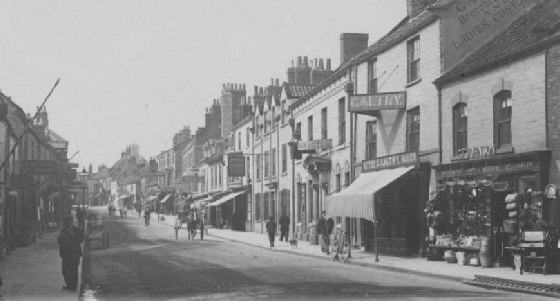Copyright © All rights reserved.



Raymond Galtry

Raymond Dalton Galtry was born in the third quarter of 1892 and his birth was registered in the Malton area. He was the second son of Charles and Mary (nee Dalton) Galtry who married in the Malton area in the second quarter of 1887.
In 1901 the family were living at 13 Saville Street, Malton with their six children where Charles carried out a tailoring business.
1901 census – resident at 13 Saville Street, Malton
GALTRY, Charles, Head, Married, M, 46, Tailor, Scagglethorpe Yorkshire,
GALTRY, Mary, Wife, Married, F, 44, Dressmaker, Setterington Yorkshire,
GALTRY, Jessie, Daughter, Single, F, 19, , Malton Yorkshire,
GALTRY, Bertie, Son, Single, M, 12, , Malton Yorkshire,
GALTRY, Elsie, Daughter, Single, F, 10, , Malton Yorkshire,
GALTRY, Raymond, Son, Single, M, 8, , Malton Yorkshire,
GALTRY, Frances Mary, Daughter, Single, F, 6, , Malton Yorkshire,
GALTRY, John William Norman, Son, Single, M, 0 (6 MOS), , Malton Yorkshire,I
Raymond’s medal card shows that he joined the 1 / 2 Battalion of Yorkshire Regiment as a private soldier and was promoted to Corporal with the regimental number 2823 which subsequently changed to 240897, and on 28th June 1917 he was gazetted as 2nd Lieutenant and it was presumably at this point that he was attached to the 6th Battalion. This unit had seen service in Egypt and, after spending the last year fighting on the Somme, were fresh from the costly victory at Messines. Raymond survived the costly and inconclusive battle of Langemarck in August and the Battle of Polygon Wood in September.
The 6th Battalion took part in the battle of Broodseinde on 4 October, the first of the Black Days of the German army. In the early morning of 4 October, news arrived at British Headquarters of the great success of the attack. Rain fell again on 4 October, continued on 5 and 6 October then became a downpour on 7 October. The rain stopped that night and the ground began to dry on 8 October until late afternoon, when another downpour began. From 4 to 9 October, over 30 mm of rain fell, in a month when average rainfall was 75 mm. Conditions for the gunners deteriorated rapidly, with dugouts flooding in the rain. A sharp increase in illness led to breakdowns in the system of reliefs, just when the workload was at its height. Instead of the usual 90 field pieces, in the 66th Division one field brigade only got 25 guns into action and the other was unable to fire until after the attack began. Journeys previously an hour long took 6–16 hours and the ammunition arrived coated with slime. Despite considerable difficulty, the field artillery was moved to within 4,000 yards (3,700 m) of the final objective and ample ammunition and field stores were brought forward. The arrangements agreed by Haig, Gough and Plumer on 2 October, the effect of the victory of 4 October and the disarray of the German defenders, led to the plan for 10 October being advanced to 9 October, with a second attack being arranged for 12 October. Attacking a front of 13,500 yards, it was planned to capture Passchendaele ridge in two stages.
To the south, 5th Division attacked Polderhoek Chateau. The Chateau ruins were reached behind a creeping barrage and the pill-
A brigade each of the 48th and 11th Divisions took 14 ½ hours on the night of 7–8 October to reach the front line through mud and rain. As the brigades attacked they were swept by machine-
The left brigade advanced to the right of Bear Copse, which was specially bombarded by mortars, inducing the German garrison to surrender. A counter-
The battle was costly for the Germans; Crown Prince Rupprecht wrote of the "oppressive superiority" of the British artillery. Despite the difficulties and the cost, the German defenders had obtained a considerable defensive success but Poelcappelle caused a "crisis in command".
The Official Historian noted 10,973 casualties in the Fifth Army for 9–14 October (Poelcappelle and the First Battle of Passchendaele, 12 October). Some of the wounded had drowned in shell-
Raymond was killed in action at Poelcapelle near Ypres on 9th October 1917 and is commemorated on the Tyne Cot Memorial. He left his estate valued for probate at £133/17/3 to his father.
Raymond Galtry is also commemorated on the War Memorials at St Leonard's Church and Malton Methodist Church.
In October 1901 they moved to better premises in Wheelgate, previously occupied by the Gazette and the Saville Street shop was taken over by Wise Bros. By 1911 Charles had been joined by his two elder sons in the tailoring business and they were still living in Wheelgate. The family were members of Malton Methodist church in Saville Street and Raymond is commemorated on the memorial there.
1911census – resident at 8 Wheelgate
GALTRY, Charles, Head, Married, M, 56, Tailor And Outfitter, Scagglethorpe Yorks,
GALTRY, Mary, Wife, Married 23 years, F, 54, Dress Maker, Setterington Yorks,
GALTRY, Albert, Son, Single, M, 22, Assistant, Malton Yorks,
, Raymond Dalton, Son, Single, M, 17, Tailors Cutter, Malton Yorks,
, Frances Mary, Daughter, Single, F, 16, Teacher, Malton Yorks,
, John William Norman, Son, Single, M, 10, Scholar, Malton Yorks,
